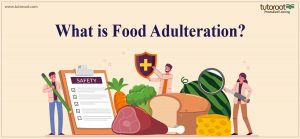What is Food Adulteration? – Methods, Types and Causes 2024
All living beings regardless of their compositions and differences, need food to produce energy. Which in turn will help them perform various important functions and observe growth. However, these days, food products are increasingly getting contaminated, as humans tend to speed up the process of food production growth through the addition of various chemicals. Thus, the process is called Food Adulteration and here in this article, we will explain food in much more detail, the reason for food adulteration, prevention methods, and food adulteration examples.

What is Food Adulteration?
As stated in the above section, Food Adulteration is defined as the process of adding new substances, such as chemicals. These substances increase the quality of the food and reduce the growth period of the product. However, because of these, the nutrients in these food products are lost. Besides, the substances are referred to as adulterants. Moreover, these adulterants are commonly observed in various food products that we use in our daily lives, such as Fruits, Vegetables, Dairy Products, Cereals, Beverages, meat, and many more.
Why is Food Adulteration Used?
Now that we have a good understanding of the Food Adulteration process, let us now learn more about the reasons why this method is actively used in making our daily food products.
- Mainly, food adulteration is used to increase the quantity of the food produced, thus increasing sales
- Secondly, food adulteration allows farmers and companies to reduce the time taken to produce these food crops, thus boosting production
- Because of the increasing population across the world, the demand for food has been also rising
- Additionally, using food adulteration reduces production costs, thus allowing individuals to gain maximum profits with very less investments
- Furthermore, imitating other companies is also the cause of food adulteration, as the companies do not have the right knowledge of proper food consumption
- Over the years, new companies, which just entered the food industry business, are employing Food Adulteration as a business initiative
Methods of Food Adulteration
The industries and farmers who produce the food products use various types of food adulteration methods to access the above-mentioned benefits. Methods such as,
- Misleading customers by adding decomposed or expired food products with good products
- Especially in fruits, special chemicals and natural dyes are actively used to polish the appearance of the products
- Furthermore, to manipulate the quantity of the products, additional materials such as clay, pebbles, and stones are actively added to it
- In addition, chemical products are also employed for fastening the ripening process and to increase the quantity of the food products
Prevention of Food Adulteration
These days most of the food products available across the world are made using food adulteration. And thus, to ensure your safety, individuals must take preventive actions to avoid eating such food products. These preventive measures include,
- All fresh food products such as vegetables and fruits should be thoroughly washed to make sure there are no chemicals added to polish them
- Besides this, we also advise candidates to check the expiry dates of all the food products before buying them and also make sure the seals are not false
- Moreover, products such as pulses, grains, etc, also must be thoroughly washed
- Furthermore, candidates should also verify whether the food adulteration occurred or not by various methods like a list of ingredients, manufacturing and expiry date, FSSAI validation, License Number, etc.
- And lastly, refrain from eating junk foods or dark-colored food products
Effects of Food Adulteration
As you can guess from the above sections, Food Adulteration seriously impacts an individual’s health. Food products made using food adulteration generally contain many toxic substances. Secondly, the products produced through food adulteration have very less or no nutrients, which are essential for the human body’s growth and development. Thirdly, the chemicals added to the products are said to be fatal, to various essential internal organs, like the liver, kidney, and heart. This, in turn, will affect the general functions, thus affecting health. Fourth, some of the added substances under the food adulteration process are said to be consisting high amounts of carbohydrates.
Conclusion
We helped you learn all about the process of food adulteration, the reason for food adulteration, and food adulteration prevention while also listing some of the popular food adulteration examples. generally, you will find many other complex topics in Biology that will be very hard to learn on your own. If that’s the case, join the Online Interactive Classes offered by the Tutoroot platform, it might be a very good option for you. Through these classes, students can access various unique benefits such as budget-friendly prices, customizable class schedules, expert staff guidance, access to the best educational material, and many more.
Frequently Asked Questions
When is Food Considered Adulterated?
A food is considered adulterated if the nutrient quality is reduced and if a valuable constituent is replaced by another substance.
How to Detect Food Adulteration?
To detect food adulteration various methods are actively employed, such as Liquid Chromatography (LC), Polymerase Chain Reaction (PCR), Enzyme-Linked Immunosorbent Assay (ELISA), etc.
Which act prevents adulteration of food in India?
Here in India, food adulteration is prevented using the Prevention of Food Adulteration Act (1954).
